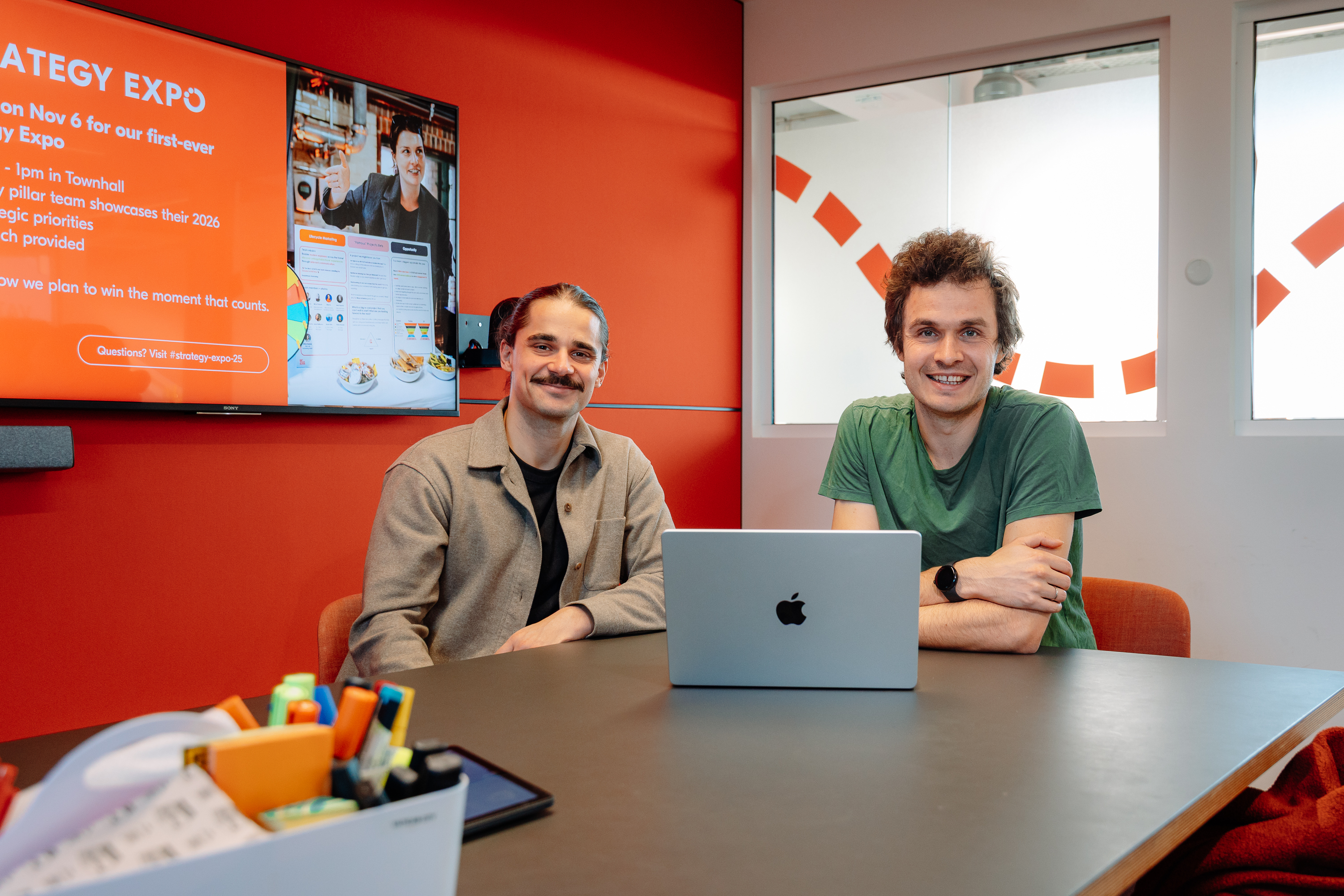How to Build a High Performance Engineering Team
The goal of bringing all the leaders together for an engineering managers summit was to encourage cross-team learning, bring new perspectives, and tackle big questions. But honestly, it was also an event to fire up the managers and have some fun. It was a breath of fresh air to take a step back and look at topics beyond our day-to-day syncs and standups.

Key takeaways:
As an engineering manager, or as any manager, you want your team to be inspired and excited about work. As we’ve settled into managing teams remotely, our CTO Udi Nir organized an internal summit for engineering managers. During the full-day online event, engineering manager Sladjana Jeremic Pajic presented on how to build high-performance teams. The formula and best practice methods she shares are a joint effort from team-wide discussions held at the event.
{{divider}}
About the summit
The goal of bringing all the leaders together for an engineering managers summit was to encourage cross-team learning, bring new perspectives, and tackle big questions. But honestly, it was also an event to fire up the managers and have some fun. It was a breath of fresh air to take a step back and look at topics beyond our day-to-day syncs and standups.
The feedback was overwhelmingly positive, with the managers feeling inspired and trading ideas across all mission teams. The topics for the online event were chosen by Udi but voted on by all of us, which was awesome because we were able to cover a wide spectrum of themes.
We had a colorful spread of technical and tutorial-based topics and others that were more creative and inspirational. Joining the video call were a few special guests from other teams who presented on themes that gave us a fresh perspective. Craig Johnson and Marlene Rossner from our UX & Design organization spoke to us about Design Thinking, and it was one of the most exciting topics for me.
How to build high performing teams
A high-performance environment is where everyone can do their best job and wants to do their best. An engineering manager needs to observe how the team works, ask questions, and listen to team members to understand what they need help with. To kick off the topic, I presented a high-performance team formula created by Rick Conlow and Doug Watsabaugh to identify critical team performance drivers:

I walked through a clarification of the terms:
The clear expectations (CE) clarifies the goals and roles of the team. Does every team member know:
- what we are building and why?
- what they are accountable for?
- what is expected from his/her role?
- other roles in the team?
The competence (C) evaluates if the team has all the needed skills and knowledge to be successful in the current project.
The commitment (C) indicates how committed and motivated the team is to deliver the project.
- Are they interested in the project, are they motivated to get things done, do they put in their best effort?
- Do they regularly go the extra mile?
The supportive climate (C) is about communication and collaboration in and around a team.
Ask the managers: Going deeper into the formula
While the above formula gives four main focus areas, it’s still missing tools to measure how a team scores at each driver. This additional criteria would give the formula a more solid structure. That’s where the rest of the summit guests come in. Engineering managers from different mission teams gathered to better define each term's measurement and improvement.
We randomly selected groups for the most well-rounded results and split them into topics: Clear Expectations, Competence, Commitment, Supportive Climate. Then we gave the managers 15 minutes to share their thoughts on a topic with one another. Each team answered two key questions per topic:
- How do we measure this?
- How do we improve this?
Here’s who presented for each topic:
- Harsh Rawat from Customer Engagement presented on Clear Expectations
- Ferran Punet, Product Analytics Manager presented on Competence
- Alexander Weiss from the Recommendation and Relevance team (RnR) presented on Commitment.
- Daniel Huguenin from the FinTech team presented on Supportive Climate
Each team then presented the results and the audience had an opportunity to ask questions or add examples. The following is a collection of the results we received:
CE - Clear expectations
How to measure
Measure clear expectations from two perspectives:
- How and if expectations were set
- How they were understood
To verify set expectations, start from the documentation you share as a company and as a team:
- Definitions & Processes: Role descriptions and competency profiles, engineering principles, best practices, development processes, business specifications
- Plannings and solution designs: sometimes, teams try to save time on these to go faster, but planning on the fly can become the biggest time waster
- OKRs & Metrics: are the objectives and key results defined? Are those clear to everybody on the team?
To make sure expectations of a project, goals, or tasks are clear across the board:
- Ask the same questions to different individuals separately. If they give consistent answers, then the expectations are clear. If needed, use 5 Whys to get deep enough to remove any unclarity.
- How confident is the team about the timeline? Do a deep dive. If a team can clearly list what has to be done next and has strong arguments behind their confidence level, it’s a good sign.
How to improve
- Clarify definitions of roles and responsibilities: Enable everybody in the team to know what they are accountable for.
- Lead by example: Setting expectations starts with the manager's behavior. It is important to align your words and actions, and to set the highest standards for yourself and for the team. With every interaction within a team, you demonstrate what actions are acceptable (e.g. praising high performers) and what actions are not desirable (e.g. addressing low performers).
- Use agile tools: For instance, SCRUM framework and its rituals can help. Here are a few examples:
i) adding goals to each sprint
ii) having tickets fulfilling definition of being ready to work, plus clear acceptance criteria
iii) maintaining a backlog that reflects priorities and goals
iv) using roadmap documents in team planning meetings to add clarity to both the current sprint and to the big picture.
- Document how a team works: Track which best practices a team applies. This way, newcomers can easily fit into the team and also contribute to existing best practices (check out the example in our Team User Manual).
Competence
How to measure
It’s critical that as a group, the team has enough competencies. Competence needs to be measured through the team’s mission in order to understand what structure the team needs.
For individuals, an EM can assess competencies against a competency profile (via performance review and feedback sessions). Keep in mind: Competence includes both technical skills and behaviour e.g. how well employees can deal with ambiguity.
Another metric that reflects the competences of the team is a bus factor, and ideally it should always be greater than 1.
How to improve
- Identify gaps and hire
- Upskill and uplevel people in the team
- Coaching and mentorship for soft skills
To upskill efficiently, we can cooperate with other teams within the company and organize multiple sessions to do a knowledge transfer: e.g. office pairing hours and workshops where anyone could join to solve any problem together.
Commitment
How to measure
Commitment spans across all the rubrics in the competency profile, not just ownership.
This component is the hardest to measure unbiasedly, but there are some indicators such as:
- Velocity of the team, how much and how many milestones do we deliver?
- On an individual level, are they willing to take over more responsibility?
How to improve?
Commitment is about being motivated, knowing expectations, and believing in the vision of team and company.
- We believe commitment can be contagious: If team members are proactive and motivated, and the manager is also a role model, then it is more likely that other team members will behave the same way.
- Empower the team: Leave more decisions up to the team. Let them decide on timelines and lead team ceremonies.
- Note: One blocker for commitment can be the lack of psychological safety, the feeling that someone feels they will be blamed if they do something wrong. To read more about psychological safety in our workplace, check out this article on our Team Development Strategy.
Supportive climate
How to measure:
Some questions and indicators for this driver:
- Trust level between team members: Do team members share feedback between each other? Is the team able to give feedback to the manager or are they afraid to do that?
- The communication flow: Does everyone participate in team sessions?
- Inclusiveness: Does the team make room for every idea? If there is a conflict in the team? Are they able to resolve it on their own or is it a blame game?
- Engagement: Is the team engaged and having an impact on team overall success (e.g. are they into OKRs discussions or do they expect others to do that?).
As an engineering manager, you can evaluate indicators by asking the right questions in one-on-one sessions. Please spend time with the team and understand the individual's situation. Use Peakon surveys wisely to collect the anonymous data, and get even more insights on hard questions.
How to improve:
- Create a safe environment where people can ask questions
- Lead by example (e.g. admitting that manager don’t know all the answers)
- Ask people who usually don't speak much in meetings to share their opinion. Try showing interest in someone’s opinion and showing them that they can also contribute and add value.
- Create opportunities to share feedback (weekly sessions, as part of team events, retrospectives)
Establish some principles which create a safe environment and make sure not to break those principles.
Your turn, where do you start?
The formula shows that performance is impacted the most by clear expectations — it's the only multiplier there. But from my personal experience, I recommend you start with the company culture. Once you take care of your people and build supportive relationships, the team will share more feedback and ideas with you. With their help, you will quickly improve clear expectations and the other two complex drivers: commitment and competence.
Final thought: An engineering manager is responsible for creating a high performance environment where employees can excel. This requires tons of ongoing observation and effort. Once built, it doesn't mean your job is done. Remember, a high-performance environment is a temporary state of a team, and the team can easily fall out of that state. Ensure you know how to recognize your team's state and arm yourself with the tools to improve it.
Interested in joining our engineering team? Check out our open roles.


.jpg)




